21 Japandi Entryway Ideas for a Calm & Stylish Welcome
A Japandi-style entryway is the perfect way to create a welcoming, serene, and well-balanced first impression of your home. This elegant design aesthetic blends the simplicity and warmth of Scandinavian interiors with the refined minimalism of Japanese decor, resulting in a space that feels both functional and visually calming.
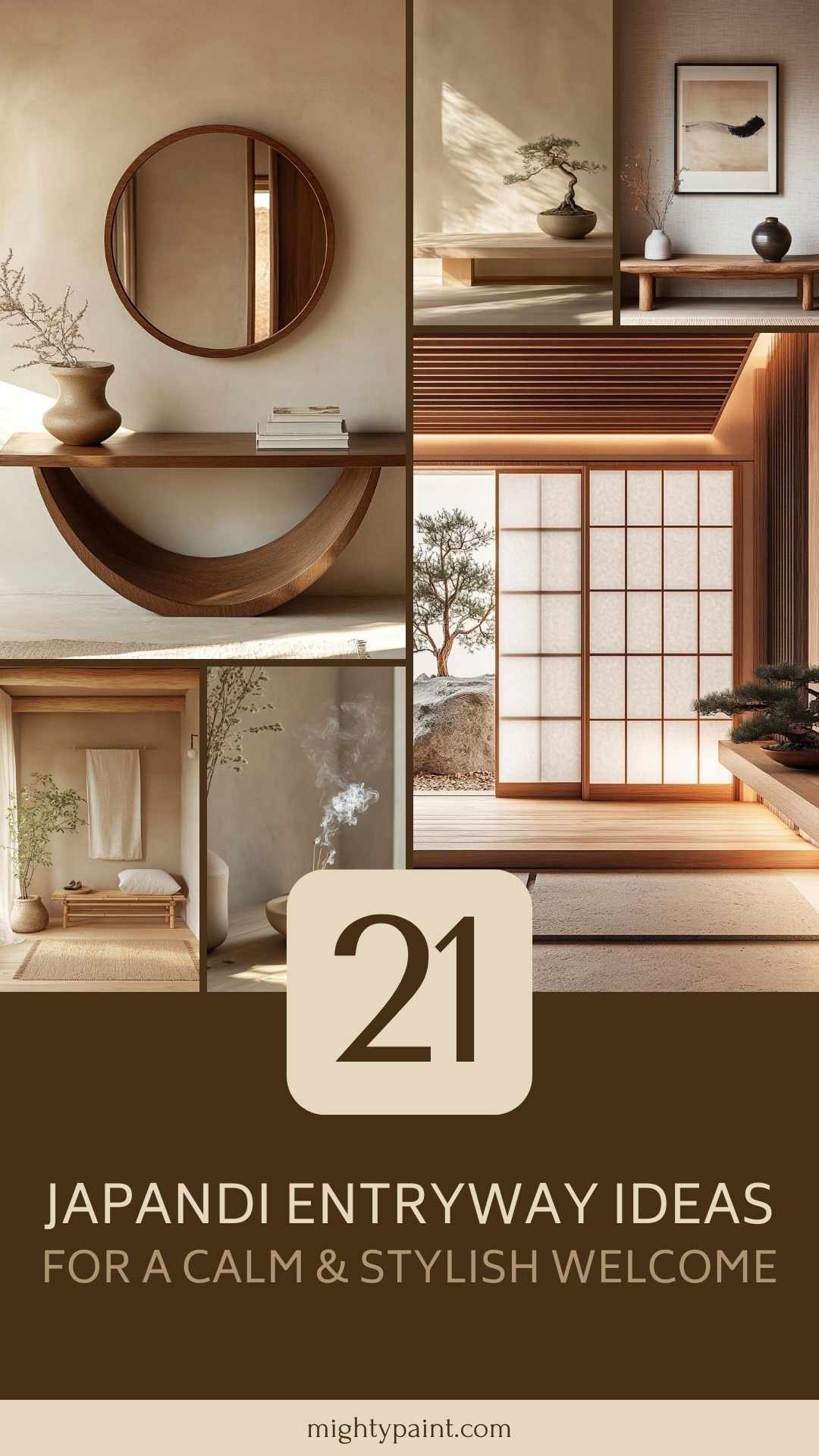
Characterized by natural materials, neutral color palettes, and purposeful decor, a Japandi entryway embraces the concept of “less is more.” Every element, from furniture to accessories, is carefully selected to maintain balance and harmony. The combination of clean lines, warm wood textures, and organic accents makes the space inviting while maintaining an uncluttered and airy feel.
In this article, we’ll explore 21 Japandi entryway ideas that seamlessly blend beauty with functionality. Whether you’re designing a small foyer or a grand entrance, these ideas will help you create a tranquil and stylish space that sets the perfect tone for the rest of your home. Let’s begin!
1. Minimalist Wooden Console Table

A sleek wooden console table serves as a functional and aesthetic anchor in a Japandi entryway. It provides a place to store essentials like keys and mail while maintaining the simplicity that defines Japandi interiors.
Styling Tips:
- Choose a low-profile table with clean lines and a light wood finish.
- Keep decor minimal—place a small ceramic vase, a wooden tray, or a single sculptural object.
- Ensure the table does not overcrowd the space, allowing for easy movement.
2. Neutral-Toned Entryway Palette

Japandi design embraces soft, muted tones like beige, taupe, warm gray, and off-white to create a peaceful and cohesive look. A neutral color scheme enhances the airy and balanced feel of the space.
Styling Tips:
- Paint walls in a soft, natural shade to create a calming backdrop.
- Mix textures by incorporating linen, wood, and stone in neutral hues.
- Introduce subtle contrast with black or dark brown accents in small decor pieces.
3. Shoji-Inspired Sliding Door
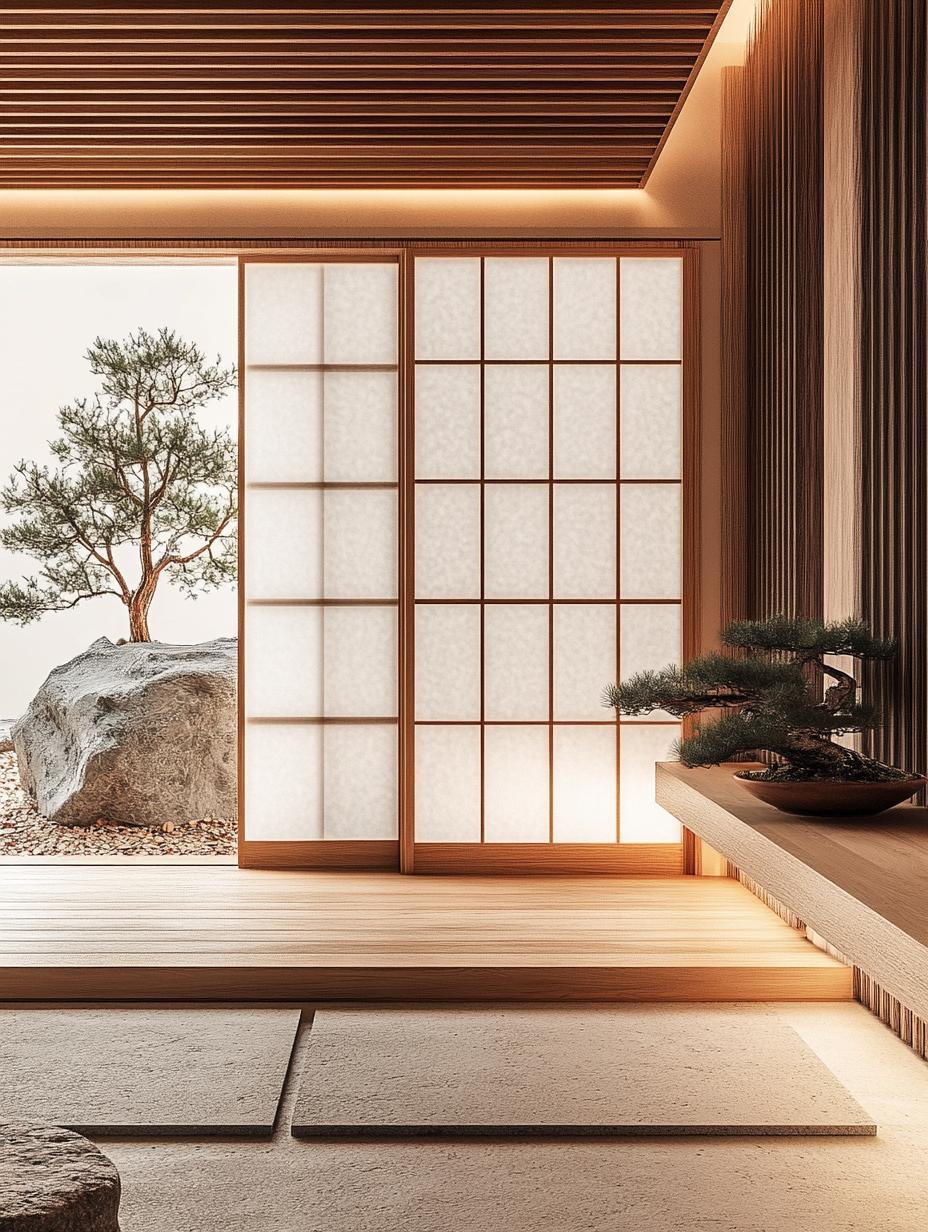
A shoji-style sliding door reflects the Japanese influence of Japandi design while maintaining Scandinavian functionality. The translucent panels allow natural light to filter through while maintaining privacy.
Styling Tips:
- Opt for a light wood frame with frosted or rice-paper panels.
- Use a sliding mechanism instead of a hinged door to save space.
- Pair with minimalist flooring and wall decor to keep the focus on the door.
4. Functional Bench with Storage

A Japandi entryway should be as practical as it is beautiful, and a bench with built-in storage offers both. It provides a comfortable seating area while helping keep the space clutter-free.
Styling Tips:
- Choose a bench with an open-shelf design or hidden storage compartments.
- Place woven baskets underneath for organizing shoes or accessories.
- Add a simple linen or cotton cushion in a soft, neutral tone for comfort.
5. Statement Minimalist Lighting
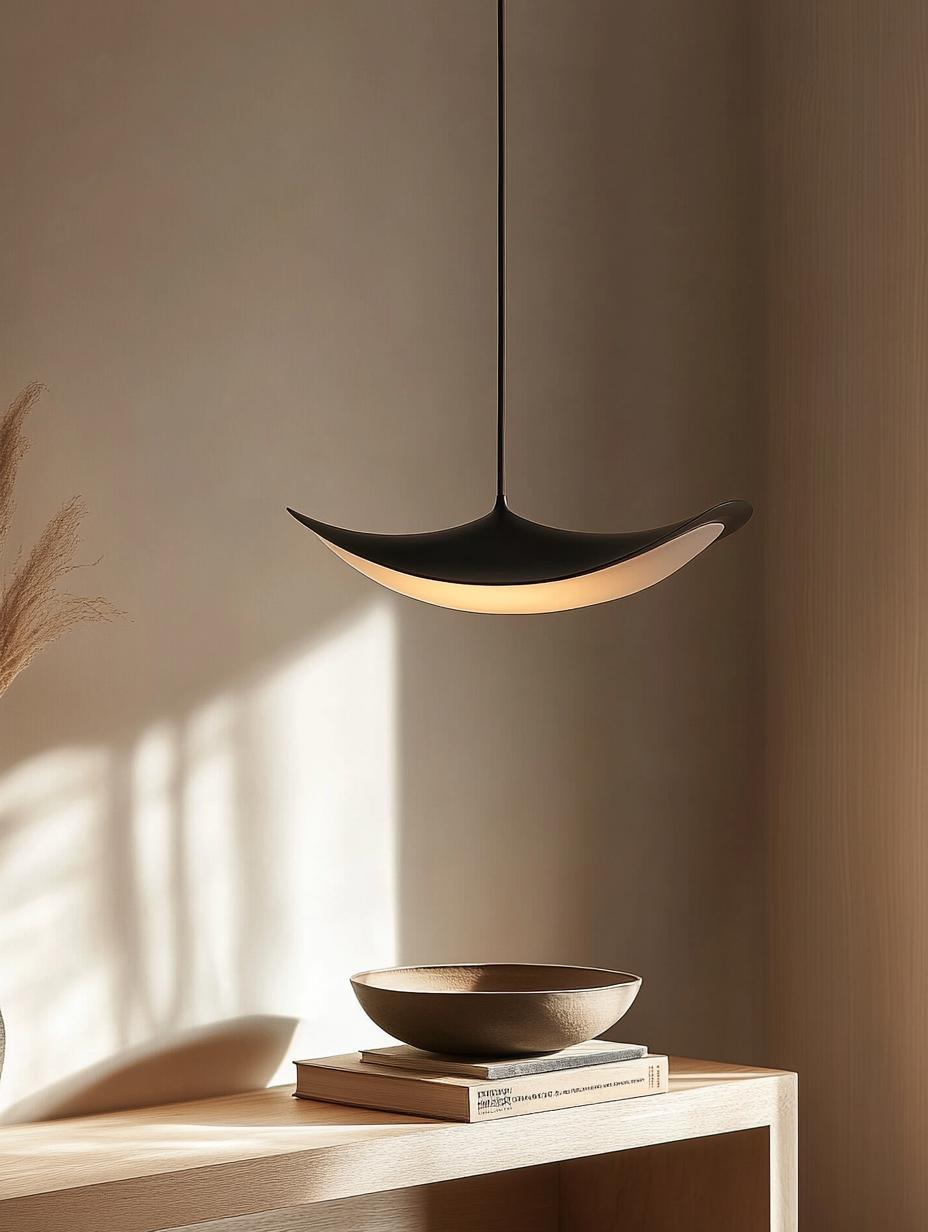
Proper lighting enhances the warmth and coziness of a Japandi entryway. A well-chosen fixture adds to the aesthetic while ensuring the space remains functional.
Styling Tips:
- Use soft, warm lighting such as a pendant light, wall sconces, or a simple paper lantern.
- Choose fixtures with a natural material finish, like wood or matte metal.
- Avoid overly elaborate designs—stick to simple, clean-lined pieces.
6. Indoor Plant for Natural Warmth

A single, well-placed plant can bring life to a Japandi entryway without overwhelming the space. Greenery adds organic texture and reinforces the connection with nature.
Styling Tips:
- Opt for a potted bonsai, snake plant, or dried pampas grass in a stone or ceramic planter.
- Choose a neutral-toned planter that blends seamlessly with the decor.
- Avoid overcrowding—one well-placed plant is enough to make an impact.
7. Wabi-Sabi Imperfect Decor

Japandi design embraces the Japanese philosophy of wabi-sabi, which finds beauty in imperfection. Handcrafted and slightly asymmetrical decor pieces bring warmth and authenticity to the entryway.
Styling Tips:
- Display hand-thrown ceramic vases or bowls with an organic shape.
- Use a raw-edge wooden stool or imperfectly textured artwork.
- Incorporate slightly weathered or antique decor to add character.
8. Rattan or Cane Accents
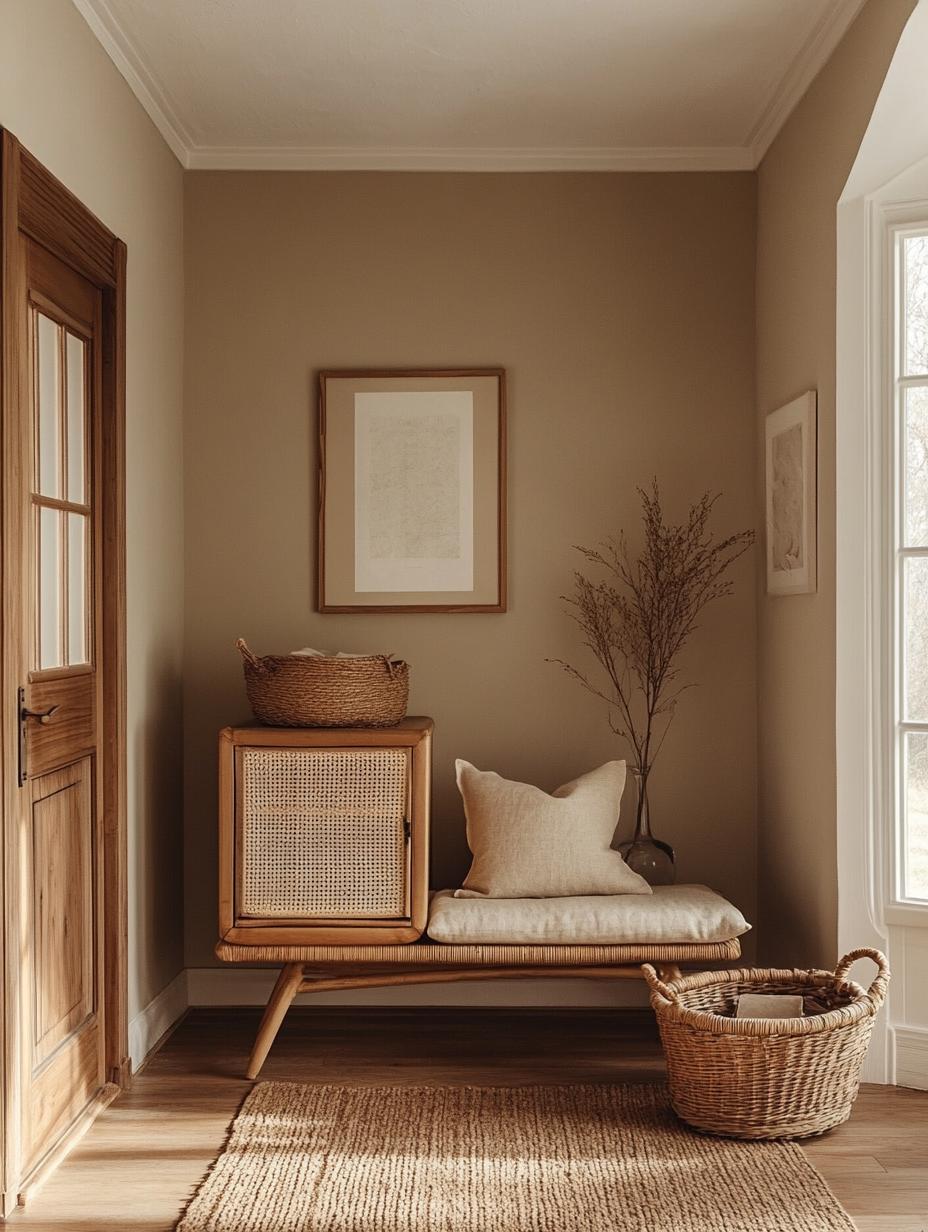
Rattan and cane materials introduce natural texture and warmth, enhancing the organic feel of a Japandi space. These woven elements add depth without feeling heavy or cluttered.
Styling Tips:
- Use a rattan shoe cabinet, cane-backed bench, or woven baskets for storage.
- Pair these textures with smooth, minimal surfaces for a balanced aesthetic.
- Keep colors neutral—stick to beige, warm browns, and natural tones.
9. Layered Natural Rugs
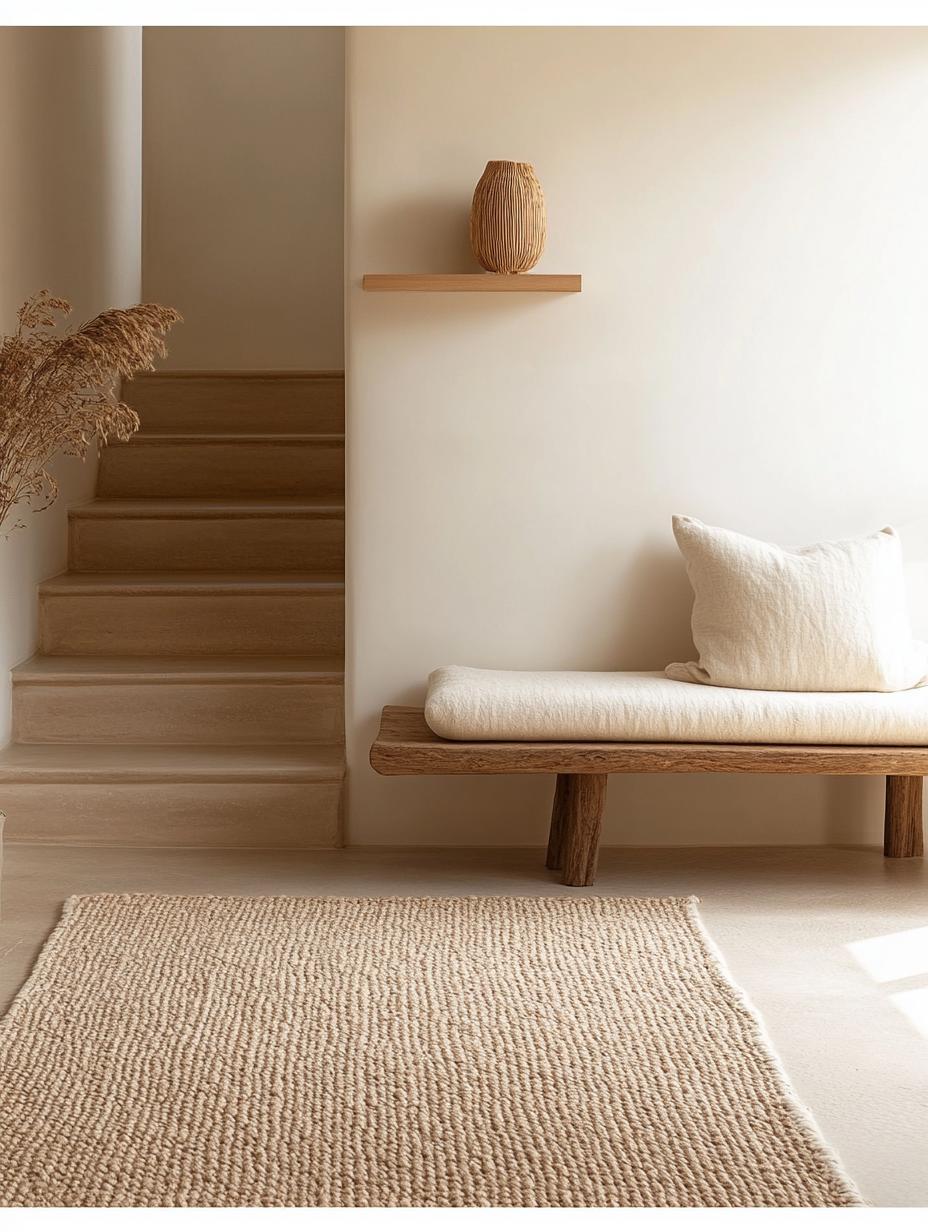
Layering rugs adds texture and warmth while maintaining the Japandi philosophy of simple elegance. Natural fiber rugs complement the minimal decor without overpowering it.
Styling Tips:
- Choose jute, sisal, or wool rugs in neutral tones.
- Layer a soft wool or cotton rug over a larger jute rug for dimension.
- Stick to muted or monochrome patterns for a subtle design.
10. Low-Profile Storage Solutions
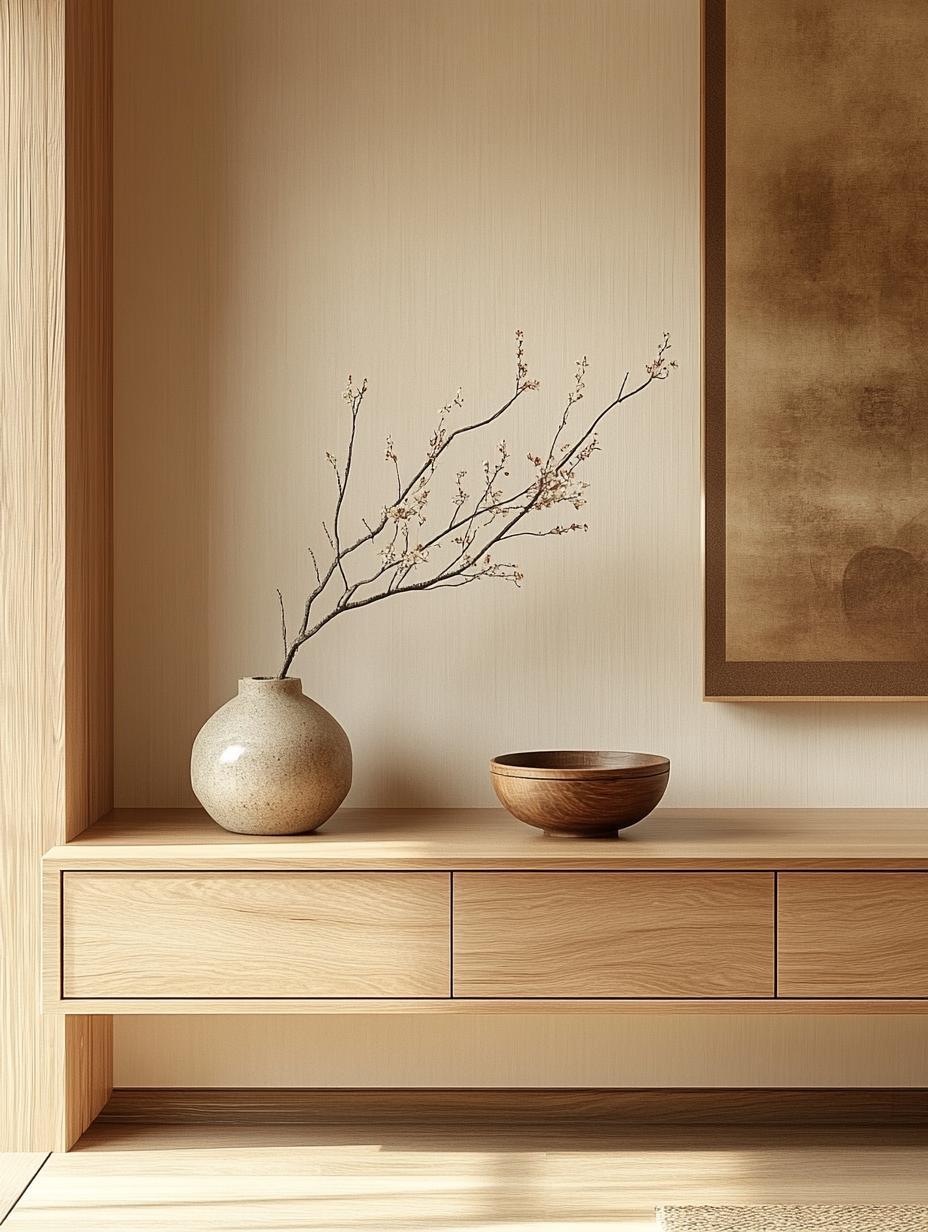
A clutter-free Japandi entryway requires smart storage solutions that blend seamlessly with the decor. Built-in or floating storage keeps essentials organized without disrupting the aesthetic.
Styling Tips:
- Install floating wooden shelves for small decorative items and essentials.
- Use built-in cabinetry with flat-panel doors for a sleek look.
- Keep visible storage minimal—use closed compartments to maintain simplicity.
11. Soft Linen or Cotton Curtains

Light, flowing curtains add a sense of movement and warmth to a Japandi entryway. Soft textiles contrast beautifully with hard materials like wood and stone, creating a welcoming atmosphere.
Styling Tips:
- Use sheer linen or lightweight cotton in neutral tones to allow natural light in.
- Keep the design simple with minimal pleats or patterns.
- Use wooden or black metal curtain rods to match the Japandi aesthetic.
12. Zen-Inspired Pebble Tray for Shoes
A pebble tray offers a mindful and visually appealing way to store shoes in a Japandi entryway. It reflects the Japanese concept of harmony with nature while keeping the space tidy.
Styling Tips:
- Use smooth, light-colored pebbles in a shallow wooden or ceramic tray.
- Place it near the entrance to encourage guests to remove their shoes upon arrival.
- Pair with a minimal shoe rack or bench for a cohesive design.
13. Wooden Wall Hooks for Simplicity

A set of wooden pegs or hooks keeps the entryway functional while maintaining a clean, minimal look. This approach adds both practicality and visual balance to the space.
Styling Tips:
- Install a row of evenly spaced wooden pegs for coats, bags, and hats.
- Choose light or dark wood to complement the surrounding decor.
- Limit hanging items to a few essentials to avoid visual clutter.
14. Floating Shelves with Sculptural Decor
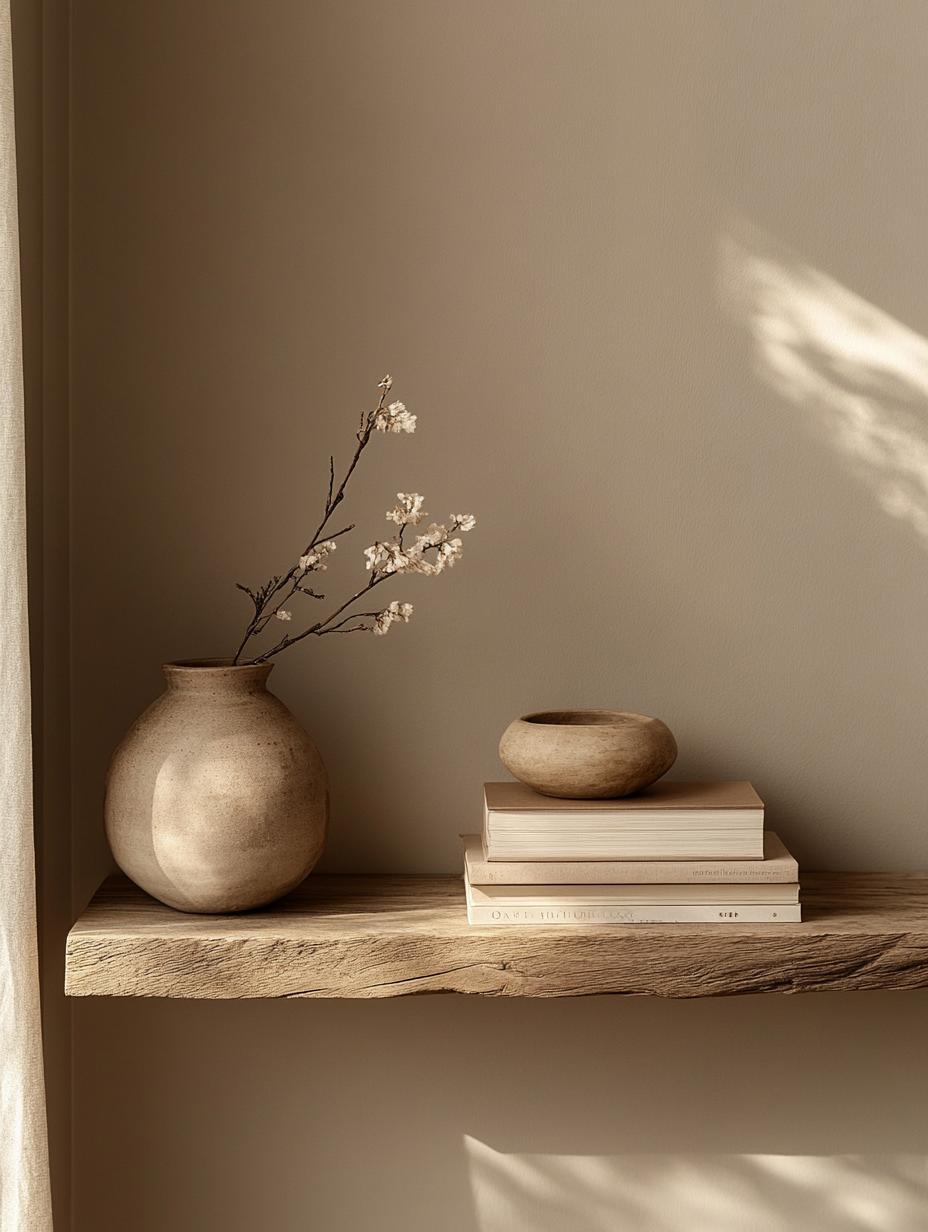
Floating wooden shelves offer a refined way to display Japandi-inspired decor without overwhelming the space. They create a functional yet stylish focal point.
Styling Tips:
- Use a narrow wooden shelf to hold a hand-thrown ceramic vase, a minimalist sculpture, or a stack of neutral-toned books.
- Keep the arrangement asymmetrical to maintain a natural, wabi-sabi aesthetic.
- Stick to two or three carefully selected pieces to avoid clutter.
15. Stone or Clay Entryway Bowl

A handcrafted stone or clay bowl adds a grounding element to the Japandi entryway while serving as a stylish catch-all for keys and small accessories.
Styling Tips:
- Choose a bowl with a matte, textured finish to enhance the organic feel.
- Use a single, large bowl rather than multiple small items to keep the look clean.
- Pair with a wooden console or floating shelf for a harmonious contrast.
16. Muted Abstract Art or Calligraphy
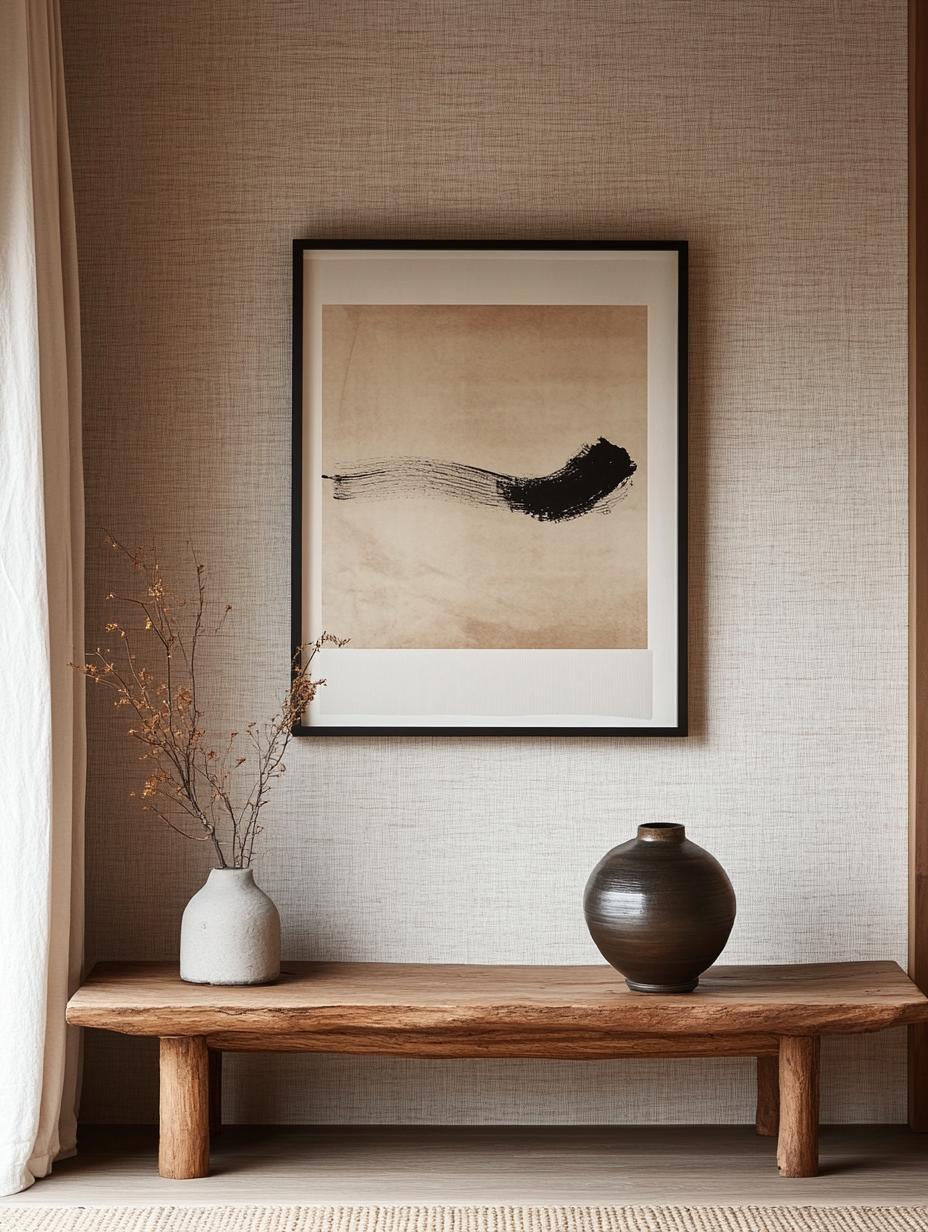
Japandi interiors favor simple yet meaningful artwork, such as abstract paintings or Japanese calligraphy. These pieces add depth without overpowering the minimalist aesthetic.
Styling Tips:
- Choose ink-wash paintings, neutral-toned abstract art, or framed calligraphy with a poetic phrase.
- Keep frames simple in black, wood, or soft metallic finishes.
- Hang at eye level for a balanced, thoughtful arrangement.
17. Furoshiki-Wrapped Storage Baskets

Furoshiki-wrapped baskets introduce an element of traditional Japanese craftsmanship while adding a unique, decorative touch to storage solutions.
Styling Tips:
- Use neutral linen or organic cotton wraps in soft beige or gray.
- Tie the fabric neatly for a polished yet effortless look.
- Store smaller essentials like gloves, mail, or reusable shopping bags inside.
18. Symmetrical Entryway Balance
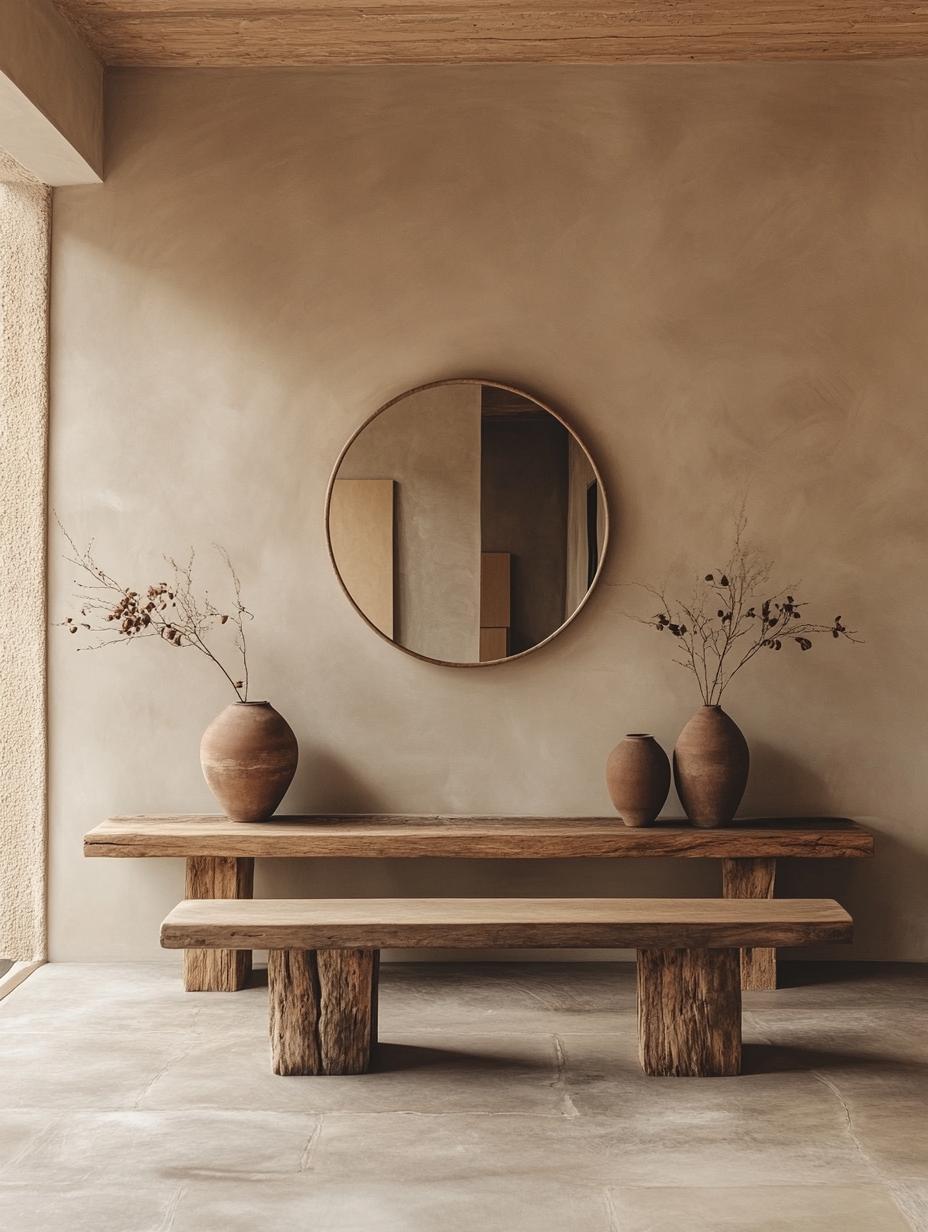
Japandi style thrives on balance and intentionality, and symmetry in the entryway creates a visually soothing atmosphere.
Styling Tips:
- Place identical decor pieces on each side of a console table or bench.
- Keep proportions even by aligning wall decor with entryway furniture.
- Use symmetry subtly—avoid excessive matching that feels too rigid.
19. Curved or Rounded Furniture Pieces

Soft, organic curves add a sense of fluidity to a Japandi entryway, breaking up harsh lines and bringing an inviting touch to the space.
Styling Tips:
- Choose a round mirror, oval bench, or arched shelving unit.
- Contrast curved elements with structured pieces like a rectangular console.
- Use smooth, matte finishes in wood or metal for a seamless design.
20. Bamboo Elements for Subtle Contrast
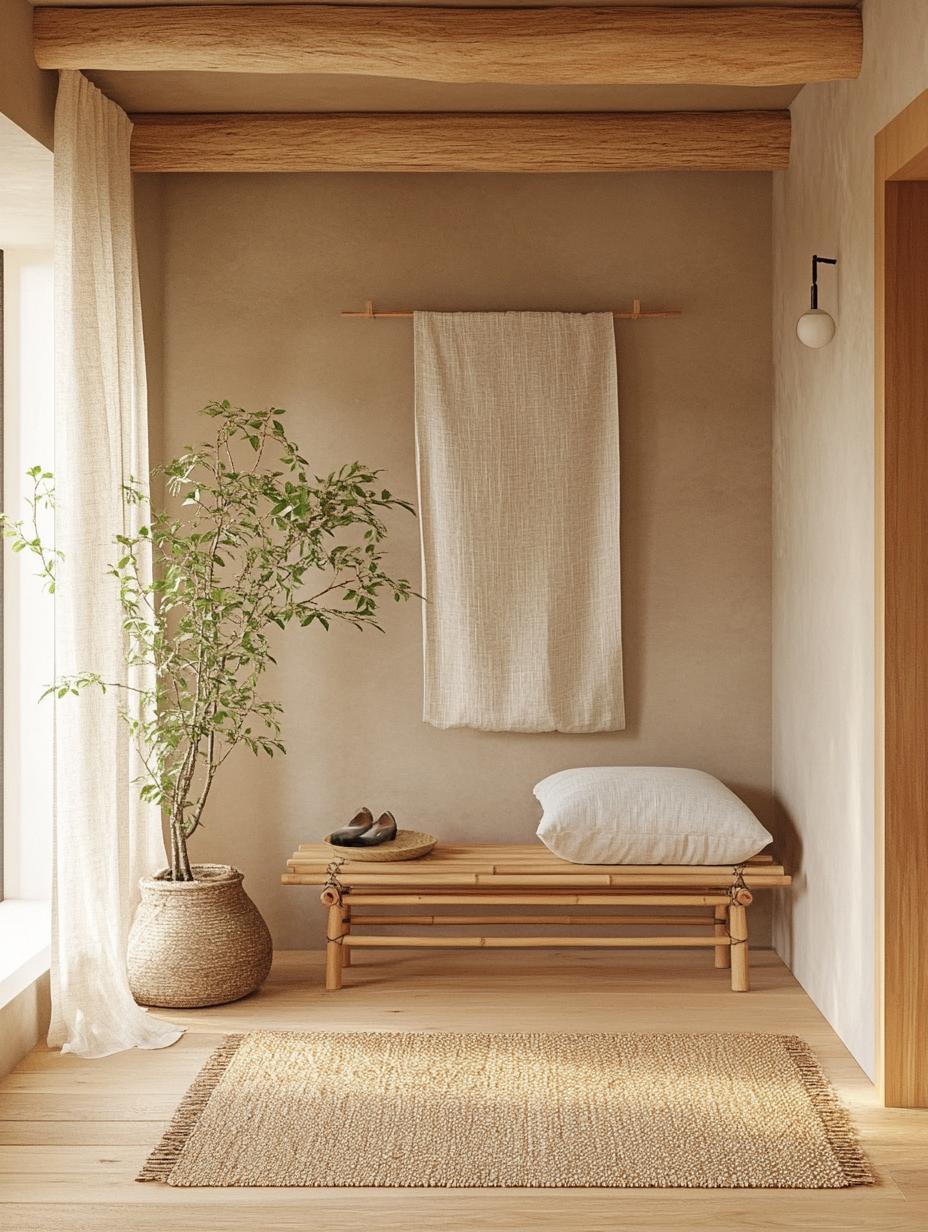
Bamboo is a lightweight and sustainable material that fits naturally into Japandi decor. It brings a subtle contrast to wood-heavy spaces while maintaining warmth.
Styling Tips:
- Use a bamboo shoe rack, coat stand, or partition for a touch of natural texture.
- Pair bamboo with neutral-colored walls and flooring for a soft, inviting look.
- Keep the finish matte or slightly polished to retain its organic feel.
21. Scented Ambiance with Incense or Essential Oils
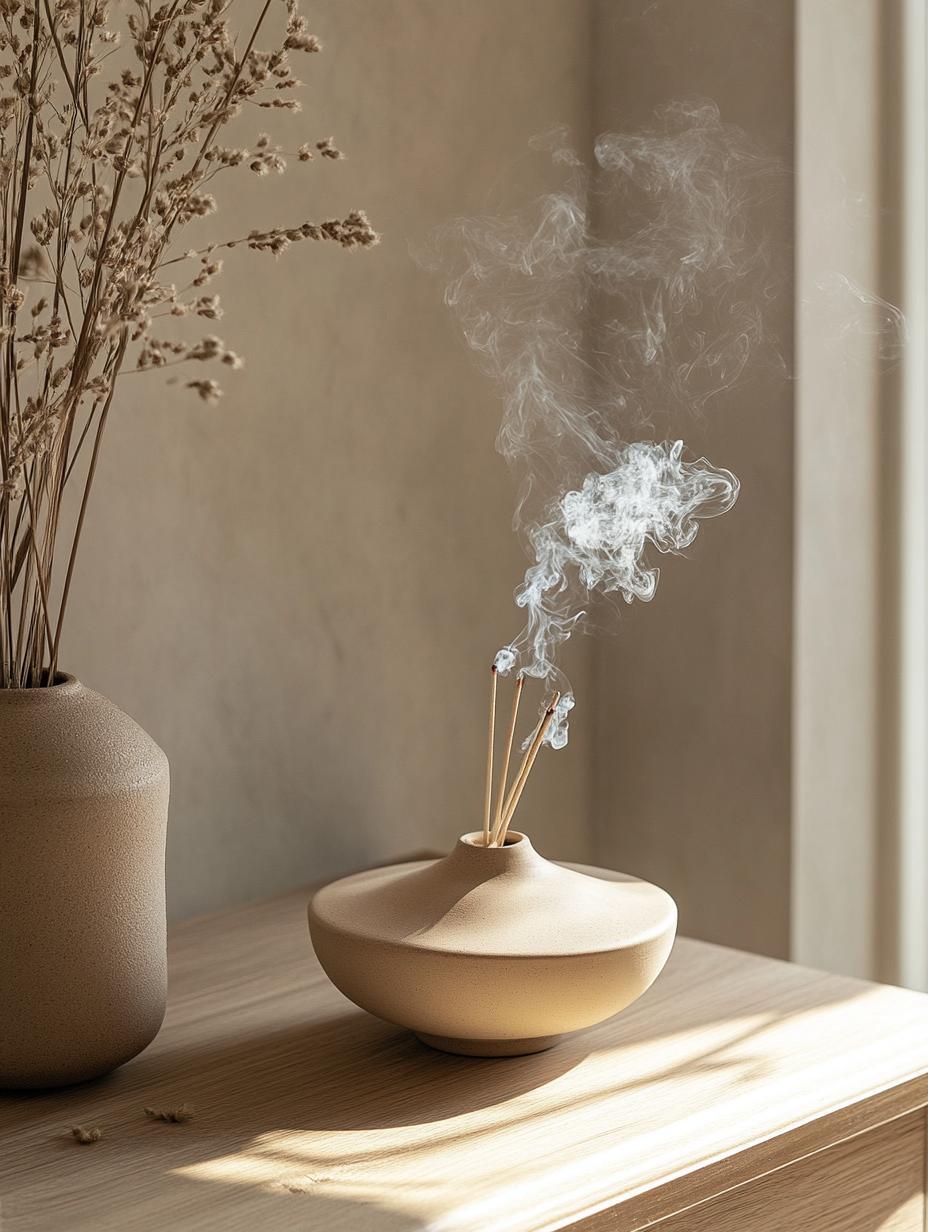
A well-scented entryway enhances the overall Japandi experience, setting a calming mood as soon as you step inside.
Styling Tips:
- Use a traditional Japanese incense holder for an authentic touch.
- Opt for natural essential oil diffusers in scents like sandalwood, hinoki, or lavender.
- Keep the scent light and subtle—avoid overpowering fragrances.
Conclusion
A Japandi entryway is the perfect blend of warmth, simplicity, and functionality. By incorporating natural materials, neutral colors, and mindful decor, you can create a space that feels welcoming and balanced. Whether through minimalist wooden furniture, organic textures, or thoughtful lighting, these 21 ideas will help transform your entryway into a serene and stylish introduction to your home.
